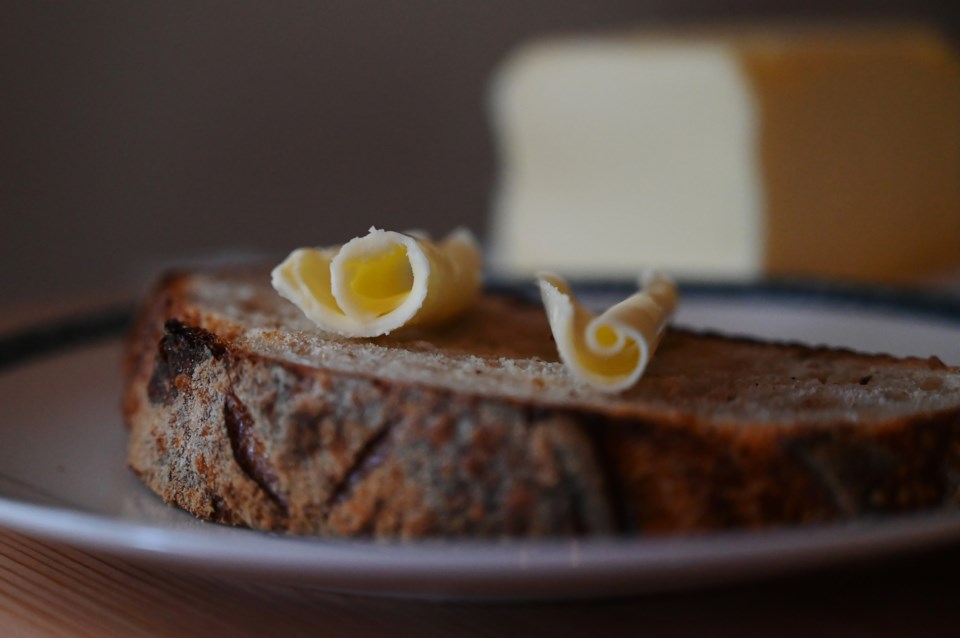A dairy producers' lobbying group is asking farmers to consider alternatives to palm supplements in livestock feed pending the results of an investigation launched in response to consumers' concerns about perceived changes to the consistency of butter.
In a statement Thursday, The Dairy Farmers of Canada said academics and industry experts will soon convene to examine the use of palm oil and its derivatives to boost cows' diets, while maintaining that the common practice doesn't raise health or safety concerns.
The inquiry comes in response to anecdotal reports that butter has gotten harder, but some experts question whether spreadability is a widespread issue.
Quebec Dairy Producers released a statement Wednesday calling on farmers to stop supplementing cattle feed with palm-based products as part of a broader look into the use of these ingredients in human food.
The association also raised concerns about the environmental impacts of palm oil production.
Alberta Milk said it's also encouraging dairy farmers in the province to find alternative feed supplements. "Canadian dairy are going to do better," chair Stuart Boeve said in a statement Thursday.
The provincial groups expressed support for the Dairy Farmers of Canada's working committee, which will set out to assess the issue based on scientific literature and feedback from consumers.
"It is essential that decisions be made on a factual basis and that science guide our sector," Dairy Farmers of Canada said.
"Notwithstanding this announcement, we stress that all milk produced in Canada is as safe as always to consume and is subject to Canada's robust health and safety standards."
At the centre of the churning controversy, which some have dubbed "buttergate," is Calgary food writer Julie Van Rosendaal, whose investigation into the issue has garnered international media attention.
Van Rosendaal said her deep dive into the dairy sector began in her own kitchen, when she noticed that it seemed to be taking longer for her butter to soften.
She took to social media to see if other bakers were having similar struggles, and was flooded with responses from users who had also detected a change in texture.
"The fact that it was people across Canada, the fact that it kept coming up throughout the season, indicated to me that it wasn't just me," Van Rosendaal said by phone.
"A lot of people are asking this question, 'What's up with butter?'"
After consulting with experts, Van Rosendaal homed in on a possible explanation for why the spread seemed to be stiffer.
Her theory, which she laid out in an article for the Globe and Mail, posits that dairy producers have increased use of palm supplements in cattle feed to keep up with demand for butter amid a pandemic-fuelled baking craze.
For about two decades, famers have added palmitic acid, a saturated fat found in palm oil, to dairy rations to boost milk production and fat content. This can affect the makeup of milk fat to increase the melting point of butter, according to researchers, which would make it harder to spread.
Van Rosendaal said it's hard to find exact figures on the prevalence of palm supplements in cow feed, but industry stakeholders she spoke to say their use is common.
"Butter isn't something that you really look at the ingredients on, because it is an ingredient," Van Rosendaal said.
"I think people are always surprised to learn about how the food system works ... and how consumer demand affects how our food is produced and made."
Alejandro Marangoni, a food science professor at University of Guelph, said in the absence of solid data, he's skeptical of claims about a sector-wide stiffening of butter.
"You have a sensationalist statement that is completely based on zero data, just some feelings," Marangoni said. "And now the dairy industry is launching an investigation, for what? It might not be true."
Marangoni, who researches fats in food, said it wouldn't take much effort to see if "buttergate" stands up to scientific scrutiny. All one would need to do is take samples of butter, measure their hardness and see if it correlates to palmitic acid content.
In recent statements, the Dairy Farmers of Canada said industry data suggests that the proportion of palmitic acid in milk fat has been within the range of expected variations over the past year.
The group also notes that palmitic acid is naturally the most abundant type of saturated fat in butter, and feeding supplements have a very limited impact on the composition of milk fat.
The Canadian Food Inspection Agency said palm oil is an approved ingredient for livestock feeds, and the practice has also been adopted in countries such as the U.S., the U.K. and Australia.
David Christensen, a professor emeritus of animal and poultry science at the University of Saskatchewan, said if the consistency of butter has changed, the use of palm supplements could be a contributing factor.
But he said there's too much uncertainty to rule out other possible explanations, such as new processing methods that can affect the formation of fat crystals in butter.
Christensen said of the 75 million metric tonnes of palm oil produced annually, 90 per cent is used by the food industry. But the availability of palm oil is limited, he said, resulting in a recent shortage in the feed industry.
The World Health Organization says research on the health impacts of palm oil consumption in foods are mixed, but some studies have linked the ingredient to increased risk of cardiovascular disease.
An Associated Press investigation last year linked the palm oil industry in Malaysia and Indonesia to abuses including child labor, outright slavery and allegations of rape. Companies have also faced criticism over land grabs, the destruction of rainforests and the killing of endangered species.
— with files from the Associated Press
This report by The Canadian Press was first published Feb. 25, 2021.
Adina Bresge, The Canadian Press



